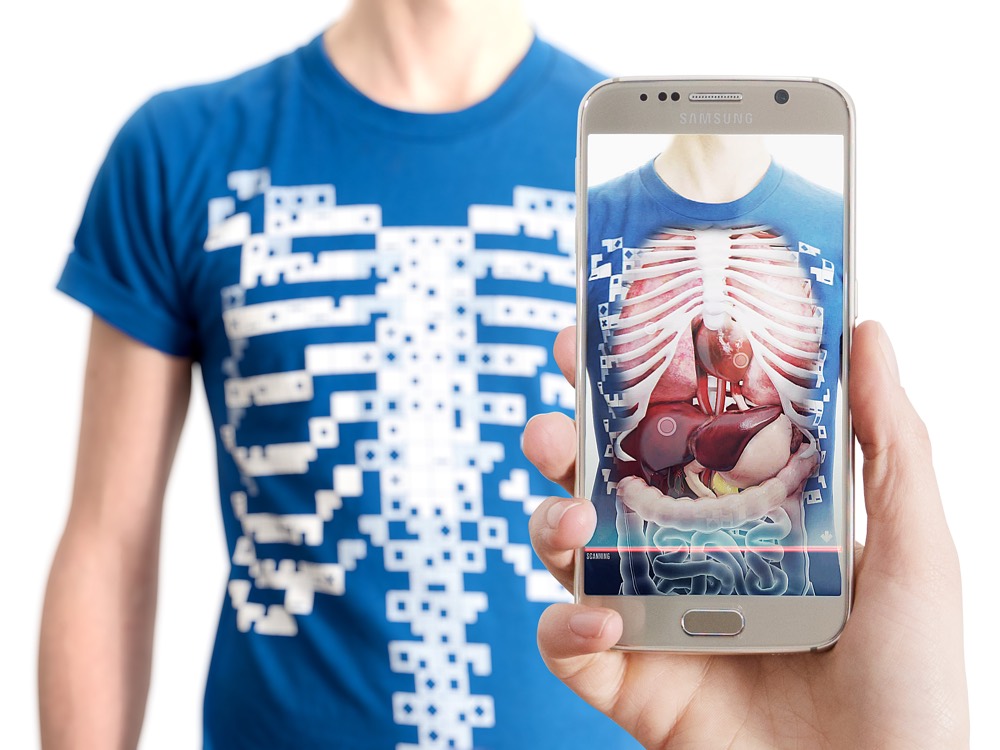
'X-Ray Vision' T-Shirt Shows Inner Workings of the Human Body

A new crowdfunded project aims to create a virtual reality T-shirt that allows users to feel like they are peering inside the shirt-wearer's anatomy using a mobile device or VR headset.
The Kickstarter project, called the Virtuali-Tee, is a T-shirt that gives people an inside peek at the skeletal, digestive and circulatory systems. The animated T-shirt is designed to teach kids about the inner workings of their bodies.
The new product is "like a magic lens combined with a teleportation experience that helps kids unlock their full learning potential," Mária Rakušanová, a product marketing lead at Samsung who works on the company's virtual-reality systems, said in a statement. [Beyond Gaming: 10 Other Fascinating Uses for Virtual Reality]
Mixed reality
The garment — which would work in concert with a mobile phone, tablet device or VR headset — is the brainchild of London-based virtual-reality (VR) and augmented-reality (AR) company Curiscope. Whereas VR headsets such as the Oculus Rift, the Samsung Gear VR and Google Cardboard envelop a person's field of vision to display another world, the new T-shirt uses AR to superimpose images of internal anatomy onto the T-shirt to create a mixed reality.
Here's how the see-through vision would work: Virtuali-Tee is covered with quick response (QR) codes, a kind of square bar code often used in ads and signage. When smartphones and other Internet-connected devices scan these QR codes, a free app from Curiscope uses the codes to overlay animated images of human anatomy over the T-shirt. People can use the app to look at someone else with the Virtuali-Tee, or use a mirror or a mobile device's selfie mode to look at themselves wearing the T-shirt.
"We wanted to make learning about the human body into an exciting experience, and it seemed fitting that the perfect way to do this would be through a T-shirt that mimics what it's like to look inside the body," said Ed Barton, CEO of Curiscope.
Sign up for the Live Science daily newsletter now
Get the world’s most fascinating discoveries delivered straight to your inbox.
Using a smartphone or tablet app, you can tap on tags for the circulatory system or the digestive system, for example, which will then trigger videos and text explaining more about that part of the human anatomy. Those using a VR headset can just center their vision on the area they wish to explore.
Future projects
The team hopes the Virtuali-Tee will inspire people to learn more about human biology. "If we can get kids thinking differently about the body and about science, I'd consider the project a huge success," Barton told Live Science. "It's great to be able to take learning off the page and to contextualize it. You'd be surprised by how many kids, despite studying the human body in a biology textbook, don't actually transfer that knowledge to their own bodies."
If the Virtuali-Tee is successfully funded, Curiscope hopes to add more functions to it. One possibility is to visualize health and disease, Barton said. For example, users could visualize the difference between healthy lungs and a smoker's lungs, or the difference between clogged and clear arteries.
In addition, the company would "love to also push the technology side of things so that the anatomy animates based on your actual heart rate," Barton said. "It's possible to do this via the beats-per-minute output from a smartwatch," he added.
The Kickstarter campaign to fund the Virtuali-Tee, which has so far raised about $67,000 toward its $90,000 goal, ends March 31.
Follow Charles Q. Choi on Twitter @cqchoi. Follow us @livescience, Facebook&Google+. Original article on Live Science.










